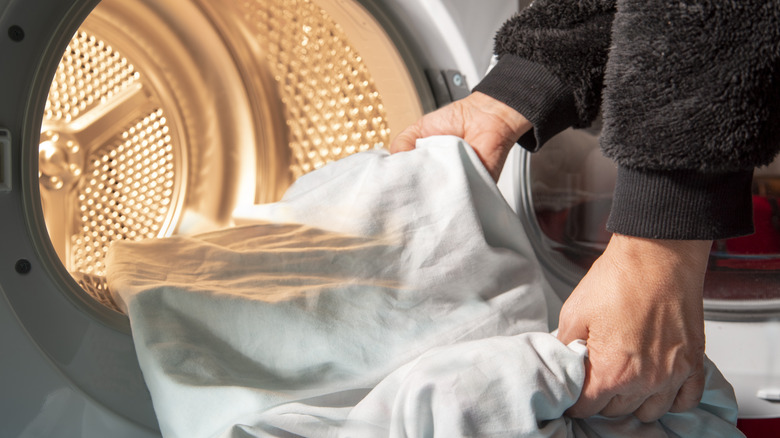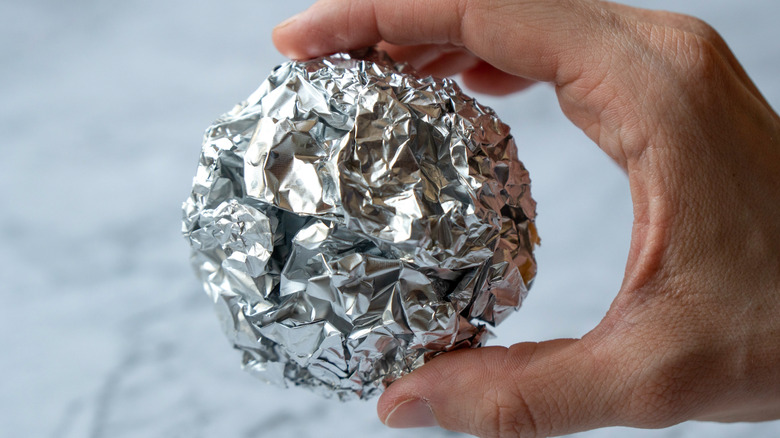Why You Should Toss A Few Balls Of Aluminum Foil Into Your Dryer
The modern miracle that is aluminum foil improves everything from microphones to the phenomenon of casserole dishes that disappear at potlucks. And there are more than a few useful dryer hacks floating around, so it's no surprise that there'd be an intersection where foil makes your clothes-drying experience better. This comes in the form of tennis-ball-sized spheres of foil that might also make a good cat toy or substitute wiffle ball.
The work your aluminum foil balls do in the dryer is mostly eliminating static electricity from your laundry. They might be a little noisier than a dryer sheet and, unlike dryer sheets or those DIY felted wool dryer balls scented with essential oils, they basically smell like the refined essence of nothing. They also don't do much to soften your clothes, but on the whole, aluminum balls are a better choice than dryer sheets.
Aluminum foil emerges after mining bauxite, chemically extracting aluminum oxide, and using electrolysis to further refine it to pure aluminum that's rolled into thin sheets. Even considering all of that, those aluminum sheets are a better choice for managing static cling than dryer sheets, which you might want to ditch. Dryer sheets can contain allergens, cause your dryer to emit hazardous VOCs, and release carcinogenic air pollutants like acetaldehyde and benzene. And, arguably, they don't always smell like something one might find in the natural world.
How aluminum balls improve your clothes drying process
Clothes pick up an electrical charge in the dryer, and those with a negative charge will naturally cling to those with a positive charge. Balls made of pennies worth of aluminum foil will discharge this electricity and prevent your going to work with a sock plastered to the back of your sweater. (Balls made of actual pennies would probably also work, but would almost certainly bang up your dryer and would be more expensive, to boot.) This all happens because aluminum is a good electrical conductor; in fact, heavy-duty electrical cables like the one entering your house are likely using aluminum. The wiring inside your house is likely made of copper, but we've already warned you about balls of pennies.
The other thing aluminum conducts well is heat, which you might have already guessed after a glimpse at aluminum engine blocks or heat sinks in electronics. It dissipates heat and, in the process, distributes that heat more evenly throughout whatever fabrics you're drying. This results in shorter drying times, which should offset all those pennies you're spending on foil.
How the foil ball dryer hack works
To manage this trick of dryer ball wizardry, all you need are three or four balls of foil as big as a tennis ball or baseball, but not a lot smaller. (That's for an average load of laundry; bigger loads need bigger foil balls.) Smooth and tightly packed balls work best. More compressed balls of foil probably work better because they have more density, which would have enough weight to keep the ball from getting trapped in a single piece of clothing through the dryer cycle. Your ball doesn't need to be one of those polished Japanese foil balls that bored people were making a few years ago; just roll it up as well as you can, pushing against a flat surface as you do. It'll be fine without the mirror finish. Smoothness is particularly important. Any jagged or grabby bit of foil sticking out is just waiting to grab your delicates and run.
Some say to replace the ball after every few loads of laundry, but most sources say the balls should last through 50 or more cycles. Just keep an eye on the balls and replace them if they look like they're at risk of disintegrating any time soon. Smooth aluminum foil balls should last longer than rough, lightly compacted ones.


